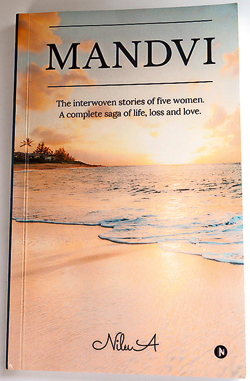Poignant tales compellingly told
View(s):Mandvi – The interwoven stories of five women. A complete saga of life, loss and love
By Nilu A
Notion Press 2020
 Mystical Mandvi, is a place the author says has held a particular fascination for her and if the name gives a hint of romance and mystery, you won’t be far wrong, for in this her first novel, mum of four and pre-school teacher Nilu A (the book’s dedication to her beloved mother may give some clue of her identity) has spun a poignant tale of women, weaving the stories of their lives with a delicate touch. There is love and heartbreak, passion and pain, loss and regret, desperate flights and unexpected reunions, all drawn into a finely spun web, the strands crossing and parting across generations and continents.
Mystical Mandvi, is a place the author says has held a particular fascination for her and if the name gives a hint of romance and mystery, you won’t be far wrong, for in this her first novel, mum of four and pre-school teacher Nilu A (the book’s dedication to her beloved mother may give some clue of her identity) has spun a poignant tale of women, weaving the stories of their lives with a delicate touch. There is love and heartbreak, passion and pain, loss and regret, desperate flights and unexpected reunions, all drawn into a finely spun web, the strands crossing and parting across generations and continents.
The author was intrigued by the stories of seafarers and traders from this port being washed up on the shores of Lanka and a recent visit no doubt sparked her imagination. For those whose geography is a little hazy, Mandvi, we are told, is a coastal town in the Kutch district of Gujarat in India which was famous as a port city and a summer resort for the Maharajas of Kutch. We see many sides of the town as the stories unfold, some in sprawling colonial mansions with landscaped gardens, others in crumbling shacks by the sea.
The women the author writes of, though vastly different in birth and circumstance are all sympathetically portrayed and the reader feels the immediate empathy with which she sees them. The book opens with the fairytale triumph of Surya Chandni Taare, just crowned the new Miss World, a stunning beauty with curiously shaped eyes. But it is the distinctive bracelet she wears on her slender wrist that captures the attention of television watchers far away– in Karachi, Scotland, Colombo and New Delhi and the story of how she came to possess the bracelet and the mystery behind it is carefully revealed.
The other women whose lives we follow are compellingly drawn. There is Bhoomi, who though born into poverty, has a rare gift. From her mother she had learned how to sew but it is her skill in creating exquisite embroidery with the long spindly fingers she inherited from her father that will take her places enabling her to leave her humble beginnings behind.
The most tragic story in the book is of star-crossed beauty Deepani, daughter of the wealthy Jadejas, she of the pale porcelain skin and unusually light eyes whose horoscope portends ill-luck for the men in her family. Her passionate liaison with the handsome drummer of a visiting dance troupe from Karachi is to have far-reaching consequences and we feel her pain as her dreams die with the morning light.
Less heart-rending is the ‘poor little rich girl’ Pavani – daughter of a wealthy businessman who throws herself into sports to win the approbation of her father. Pavani discovers her own talents and business acumen when she launches her fashion label in Bombay. When she comes to Mandvi representing her father at the wedding of the daughter of one of his business associates, she comes into contact with both Bhoomi and Deepani….
Magni, the bonny baby girl, whose mother dies giving birth to her goes from a stubborn child to a head-turning model whose wilful independence is somewhat tempered when she meets a dashing Scot whose gentlemanly charm wins her heart….
The story of three generations is told in the book’s three parts. Caught in the fast moving saga, one reaches the end with a feeling that the story could have been so much more –for the author seems to have the skill and capacity to flesh out both her characters and the different locales that the story moves to with a much broader sweep than she has attempted in this her debut novel.
The language is fresh and engaging but an absence of dialogue limits the narrative. We journey with Nilu’s characters to the grand houses of Mandvi and the mean streets of Karachi yet sometimes feel the lack of scene setting that readers need to root their characters in and give them greater identity. Mandvi, the place itself invites greater exploration, for the author’s interest succeeds in spurring similar curiosity in the reader.
Such little quibbles aside, Mandvi is an engrossing read and a debut that one hopes will be followed by more from an author whose storytelling skills are clearly evident. The book too is beautifully presented and the glossary at the end also useful for readers unfamiliar with a South Asian setting.
Renuka Sadanandan


